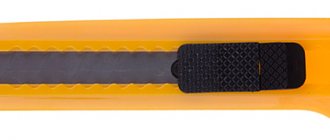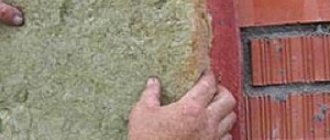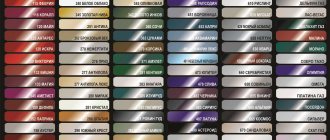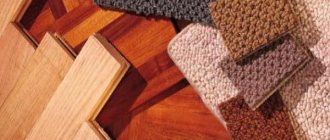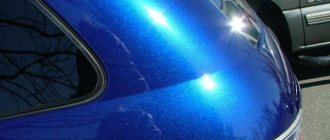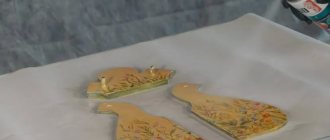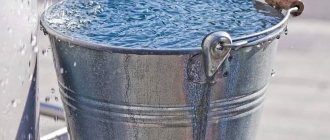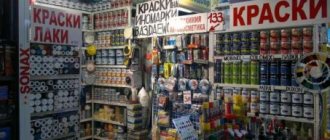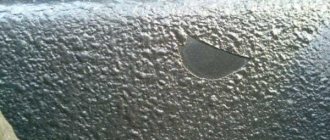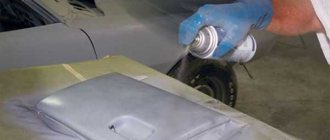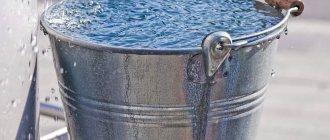Paints for modern cars are endowed with excellent quality characteristics, which allows you to create an ideal glossy finish. However, not every paint can protect the metal surface from rust. In this case, the raptor coating will come to the rescue.
During active use of vehicles such as a jeep, pickup truck, Niva and light-duty trucks, scratches and visual defects often appear on the paintwork of the body surface.
Over time, rust will form in damaged areas when exposed to moisture. Because of this, the appearance of the car loses its attractiveness. To help the car enthusiast cope with such problems, a large number of protective equipment are available on the automotive market today. The most effective product is considered to be from the manufacturer U-pol – raptor pol.
In retail sales, Raptor pol is sold in a package that includes 5 containers. One container (liter) is filled with a hardener, the remaining 4 (each 750 grams) are filled with a special chemical composition.
The kit includes a gun designed for applying this product, which has properties such as anti-corrosive and anti-gravel. The gun nozzle is carefully calibrated, which ensures high-quality application of the prepared composition with your own hands.
To cover a small area of the body, you can use a regular brush. Each bottle is designed for use in conjunction with a pistol.
Today, a car enthusiast can purchase a set with a product in black and cloudy white shades. The latter is used to create almost any color for car painting. The kit also includes detailed instructions on how to paint the surface of a car with raptor.
Rating of protective coatings for car bodies
Coatings are needed to operate a vehicle on dusty, sandy or gravel roads. After application, the appearance will remain fresh and beautiful; you will not have to admire the rust caused by exposure to detergents and spend money on restoration. Synthetic polishes do the best job of protecting: they shield the paint from fuel oil and dirt. If you do not use polish, 2-3 years after purchase the paint will turn pale and small chips will form on the body.
If this happens, restorative agents will mask minor scratches, and the aerosol will preserve the color, making it rich and shiny.
Polishes vary in consistency, composition and purpose of use. Our team researched professional articles and conducted computer analysis of reviews and ratings to identify the best options using the following criteria:
- Difficult to apply and maintain;
- Compound;
- Lifetime;
- Consistency;
- Environmentally friendly.
We also used the opinions of experts in detailing, expiration dates, company experience, and user photographs to assess the reliability and include the nominee in the rating. Ceramic, synthetic and glass external protective coatings have become the most popular.
Advantages and disadvantages of coating for cars
This polyurethane coating is a product that has been successfully developing coatings for car bodies for more than 60 years. Painting with raptor forms a protective coating that can protect the paintwork of an SUV body, for example, a Niva, from damage.
The main advantages of the substance include:
- excellent durability of the resulting film on metal;
- coating resistance to intense friction;
- resistance to chemical attack;
- Raptor pol does not fade from sunlight;
- providing such useful properties as anti-corrosive and anti-gravel.
At the same time, raptor sex also has its drawbacks. The main ones should be highlighted:
- painting the floor with raptor does not provide for subsequent varnishing, because of this the car body will always be matte;
- the surface of the metal after applying a coating with anti-corrosive and anti-gravel properties takes on the appearance of an orange peel, this does not always make the car aesthetically pleasing;
- If the rules of coating are violated, chipping may occur in the future.
Useful! Despite its shortcomings, this coating still protects metal better than most car paints. The body of a Niva or other SUV will have better resistance to rust.
The best protective polishes for car bodies
Polishes come in Teflon, silicone and polyurethane - all consisting of synthetic substances or particles of mineral origin. Wax coatings are distinguished by their eco-friendly plant composition, but, despite their demand, they are expensive and rare. Wax is found in polymer coatings, as it has a natural shine and retains color well, but, unlike polymers, it is short-lived - its resistance to detergents is 3 times lower.
Which protective coating for your car should you choose – wax or Teflon? Our team, based on the feedback and experience of a professional, has selected suitable polishes for the most harmful paints.
Grass Hydro Polymer
A small bottle of polymer with carnauba wax is enough for 2-3 times full coverage. Used to protect against moisture, care for paintwork, plastic and chrome parts, and create a radiant shine. The silicone emulsion in the composition forms a polymer film, protects against moisture, enhances the depth and brightness of color, and prevents clouding of plastic, rubber and glass.
The hydrocarbons included in the composition perfectly preserve the protection, make it smooth, shiny and pleasant to the touch, and protect it from road reagents and salts. Adheres to a clean, damp surface. Used after washing for one-step paint treatment. Shake before use.
A large amount of water and polymers in the composition preserve the product for two years.
Advantages:
- Hydrophobicity;
- High quality;
- Shine;
- Anti-rain.
Flaws:
- Flimsy sprayer - leaks and breaks.
Can be applied to unpainted plastic, then rinse off excess and wipe dry. Compared to hard polishes, it applies and dries in 5 minutes. On average, it lasts about 3 months even after 8 washes.
Koch Chemie Micro Cut M3.02
Abrasive finishing coating of liquid consistency with a restorative effect. After use, F6 polishes the surface, eliminates stains and scratches. Excellent for colored and monochrome bodies and motorcycles. Despite the volume of 250 ml, it lasts a long time, and the long shelf life of 4 years makes the product durable and long-lasting.
When using a polishing machine, the coveted mirror shine is achieved and lint from napkins is eliminated. To remove polish residue without causing scratches or streaks, it is recommended to use branded microfiber without kettle seams.
Advantages:
- Spectacular shine;
- Regenerating effect;
- Long shelf life;
- High-quality composition.
Flaws:
- Unsuitable as a base;
- Does not withstand extreme temperatures.
The car shines brighter than after buying it at a car dealership. The surface is smooth and shiny, there are no micro-scratches at all.
Ruseff
Liquid spray with water-repellent properties, intended for all shades and surfaces of bodies, except matte paintwork. The three-component composition protects against the effects of ultraviolet rays and road reagents, and is easily distributed with a suede cloth or microfiber. It only takes 2-3 clicks per part to make the surface shine.
The spray not only protects against corrosion on chips, but also makes minor scratches invisible and evens out the reflective surface, making the coating smooth and shiny, like rich glaze. The created protective film withstands acid rain and detergents. It is recommended to use contactless washes and spray onto a damp surface after using concentrate shampoo to achieve a glazing effect.
Suitable for the coldest regions of Russia, where roads are treated with eragents in winter.
Advantages:
- Ease of application;
- Economy;
- Safety;
- Quick hand application.
Flaws:
- Not found.
The manufacturer recommends using a branded two-component shampoo concentrate and cleaner to maintain the quality of the coating and provide complete car care.
The best compression gauges
The best liquid glass for car bodies
Liquid glass for cars made of nanoceramics, silicon dioxide or fluorine protects against UV rays and scratches. It is necessary to apply the solution with a melamine sponge onto the degreased surface of the paintwork. Within 1-3 hours the composition dries - a durable film with a hardness of 7H is formed.
Willson Body Glass Guard WS-01238
The durable film repels dirt and water, imparts a bright, rich shine and can withstand 40-50 contactless washes. The safe composition preserves the color of the paintwork and protects against microdamage.
The kit includes a product, a hardener, a pipette, a glove, an applicator, and two wipes for preliminary and final polishing.
Advantages:
- Easy application;
- Spectacular shine;
- Set;
- Color enhancement;
- Burnout protection.
Flaws:
- High price;
- Thin layer.
Buyers write that the layer is most suitable for polishing small places where the sun's rays and dust do not reach, for salon protection.
Soft99 H-7
A one-component product based on silicon compounds and solvents. It adheres well to the surface, protects against aggressive environmental influences: rain, snow, dirt, sea water and abrasive effects, and gives a magnificent caramel shine. On average, it lasts for a year, depending on the amount of reagents on the roads.
Before use, clean, degrease and dry the surface. The solution must be applied to a sponge, spread over the surface using horizontal and vertical movements. After 2-5 minutes, wipe the surface with a clean cloth to remove stains. The liquid sets within an hour, and complete polymerization occurs within a day. Professionals recommend avoiding high-pressure washers for a month after application.
When repairing polished body parts, they turn to specialists, since the layer is so strong that it is difficult to remove. The average consumption per machine is 30-50 ml, and the five-year shelf life allows it to be used 2-3 times on one machine.
Advantages:
- Rich caramel shine;
- Anti-rain and anti-dirt;
- Scratch protection;
- The effect of moisture on black.
Flaws:
- Difficult to apply;
- High price.
Suitable for processing paintwork, unpainted and transparent plastic, metal, chrome parts, glass. Do not apply to rubber elements, as this will lead to damage and poor quality results.
Crystal Coat Plus WAX 15900006
The spray with the new Double Crystal Coat formula is applied in two spray layers over an area of 20 cm². Before use, shake for 2-3 minutes, and then wipe the dried layer with a thin cloth from the kit.
The bottle contains 300 ml of solution, which is enough for 2-3 cars for 5 years. The manufacturer offers a shampoo and cleanser to remove fine scratches in addition to the coating. The cloth must be dry before polishing.
Advantages:
- Easy to apply;
- Low consumption;
- Low price;
- Water-repellent effect;
- Fine spray;
- Protection from dirt.
Flaws:
- Lint cloth included.
Users report excellent shine when applied to a damp car.
The best cars for large families
How much does Raptor paint cost?
Raptor paint is sold in ordinary plastic or metal containers. There are bottles on sale that can be immediately mounted on the spray gun.
The price for 1 liter, when compared with conventional car enamels, is approximately 50-70% higher. The cost of 1 liter of Raptor paint, depending on the color, form and class, is around 1500-2000 rubles.
Recently, Raptor paint in cans has been in demand. Despite the more convenient form of release, its cost is not much higher than in regular packaging.
Professional paint shops buy this paint in bulk in its simplest, unprepared form, and then prepare it themselves. Craftsmen who paint car bodies and other metal surfaces through practice develop the required consistency of the prepared paint and the technology for performing the work.
The best ceramic coatings for car bodies
Nanoceramics are resistant to scratches and chips, protects against chemicals, corrosion and sunlight. The hardness is due to silicon dioxide, which has excellent resistance to reagents. The quartz and titanium dioxide included in the composition make the protective coating of the body presentable and glossy. Reviews note that the composition often includes polymers and natural minerals to preserve the color, purity and evenness of the paintwork, protection from water and dirt. Additional substances and solvents provide heat resistance, solubility and adhesion of the coating.
Hendlex M3
Resistant to chemicals, water, color and time - all this will create a perfectly smooth varnished surface, preserve the salon color, enriching it with a caramel shine. Makes it easier to clean from oil stains and stains, prevents chemicals from coming into contact with paintwork, and protects the metal from moisture.
Powerful moisture protection is due to the large contact angle, and the hardness of the 9H coating and heat resistance allow it to withstand temperatures from -70°C to + 150°C. The hydrophobic effect does not disappear even after 100 two-phase washes, and the durable structure keeps the coating beautiful and neat for 2-2.5 years.
Advantages:
- Three packages to choose from – 20, 30, 40 ml;
- Low consumption;
- Wear resistance;
- Low price;
- Heat resistance;
- Spectacular shine.
Flaws:
- Short shelf life;
- Difficult to apply.
The product must be applied within a year from the date of production. The small bottle is due to the economical consumption of the product - only 20 ml is required for 2 layers for a medium-sized sedan. Suitable only for detailing masters, as it requires compliance with temperature and atmospheric conditions.
Detail GQ (General Quartz)
Professional product for cars and trucks based on silicon organic polymer. Creates a mirror shine, makes the color rich and deep, protects the surface from damage, corrosion, solar aging, dirt and rain stains. Aliphatic hydrocarbons provide excellent solubility and adhesion, making the surface streamlined and smooth.
Durability is due to two factors: hydrophobicity, resulting from a large contact angle, and dolomite hardness of 4 Mohs units. The hardness is reduced due to the fluorine-containing polymer in the composition, which provides protection against road reagents. The silicone component promotes uniform, economical distribution of the product and gives the coating a spectacular rich shine. Organic solvents make the product more environmentally friendly and gentle on paintwork.
The result is a coating that is resistant to alkane and aromatic solvents, which lasts for a couple of years.
Advantages:
- Low price;
- Economical consumption;
- Mirror shine;
- High level of protection;
- Wear resistance.
Flaws:
- Non-ecological composition;
- Difficult to apply.
High resistance to reagents in the range of 3-12 pH.
What is Raptor paint?
The Raptor coating in the traditional sense is not exactly paint. This is a polymer multicomponent composition. The exact list of components included in the paint, as well as the production technology, are not disclosed by the manufacturing company. However, it is known that Raptor U-Pol is basically a quick-drying polymer that does not require the classic hot application scheme.
There are many differences between Raptor paints and conventional enamels used when painting cars at factories. Firstly, this paint is an exclusive product. There are similar compositions on the market in small quantities, but their characteristics are far from the original. While car paints are produced by many companies. Secondly, this coating is not used in any automotive production line. The same cannot be said about small factories that produce various metal structures.
Also, Raptor polymer paint is rarely found in markets or small regional stores. It is mainly sold in large partner stores of the company, which was previously explained by its low prevalence and low trust among motorists. Although recently, due to growing demand, it has begun to appear more and more often in small retail.
Separately, it is worth mentioning the nuances of application technology. The so-called shagreen - a fine-grained relief on the surface of the paint - is a variable value. The size of the grains, their frequency and structure on the painted surface strongly depend on the method of preparing the paint and the process of its application. To put it more simply, if you give the same paint to two painters, the output will be a coating with different roughness. Even the color will be slightly different.
This feature of the paint means that in case of local damage, you will have to at least repaint the entire element. In the case of Raptor paints, no standard procedures for selecting or smoothly transitioning colors can be performed. In addition, the master and the tool used during the work must be the same as during the initial painting. Otherwise, the texture of shagreen may differ from other elements of the body.
How to choose a protective coating for a car body
There are 3 main types of coatings: polymer, mineral and organic. Polymers include polyurethane, Teflon, rubber; mineral – nanoceramics, liquid glass; to organic - containing wax. Each character has different purposes of use: from road dust and stones, for beauty, from chemical reagents, corrosion and solar aging. Our team has made a selection of three main factors on the basis of which a polish is chosen.
Type of protective coating
The article discusses three types of polishes:
- Polymer;
- Liquid glass;
- Ceramic.
The polymer consists of a polyurethane emulsion, which gives the coating softness, beauty and shine, making it easy to apply, short-lived and inexpensive. Suitable for cities where there is little soil, stones and dust, but a lot of reagents.
Liquid glass is made from silica with the addition of solvents or fluorine. This is a medium-priced option, resistant to moisture, dirt and small stones. Suitable for rare country trips and old roads.
The ceramic road is beautiful and lasts a long time. This coating is used before sale, at races or for a business car. Application of the product is economical, but requires certain conditions and speed.
Durability
Depends on the composition and hardness on the Mohs scale. The hardest in the budget category are 9H, which can only be processed with diamond, equivalent to ruby and sapphire. The most common are 7H - the standard hardness of silicon oxide, or quartz, which can also only be processed with diamond, although it is 4 times less hard. The softest ones are fluorine-containing coatings, suitable for city roads with a large amount of reagents, but for unpaved areas they will be too unreliable.
Coating thickness
Thickness is measured in microns. It is needed to find out which layer of coating can be removed without damaging the paint and primer. The factory thickness of the paintwork is in the range of 80-170 microns.
Polishes and nanocoatings do not significantly change the thickness, while protective carbon and matte films increase the value by 100-200 microns. Too much thickness will look like glaze or glass enveloping the surface of the car.
Opaque hard coatings, such as anti-gravel or Raptor, will create an extremely thick layer that will be difficult to remove at home.
Durability
Durability is determined by durability, type of paintwork, and external factors. Harder mineral coatings last longer than thin polymer or glass coatings. Anti-gravel and the legendary “Raptor” with its rough matte layer, reminiscent of tank armor protection, are considered the most durable.
It is more difficult to apply the product to matte paintwork; black paints hold the color best and are combined with an effective shine; there should be no stickers on the car. The protection looks unfavorable on multi-colored images and pearlescent textures, but it will only emphasize matte fluorescent shades.
Which protective coating for car body is better?
We analyzed comments on forums and reviews of various coatings, revealing that, according to users, mineral coatings are of the highest quality and wear-resistant. However, we have prepared options from 3 article categories for different application purposes and locations:
- If you need a smooth, glossy, budget-friendly coating of a car’s hood, a protective film that falls on the paintwork with the owner’s light hand, Ruseff is suitable;
- Will create the impression of presentability, protect against corrosion, water and reagents liquid glass Crystal Coat Plus WAX 15900006;
- Hendlex M3 nanoceramics will protect against UV radiation, stones and aging, maintain deep rich color and give a mirror shine.
Before use, pre-treat an old minor part to determine the thickness of the coating, drying time, difficulty of application and evaluate the appearance.
